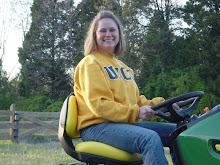
My hubby and I are always building things. We build storage buildings. We built a riding arena. We remodeled our house which consisted of putting in new flooring, building cabinets, constructing countertops. We are currently building a chicken house. And we are systematically replacing all the furniture in our house with furniture in which my husband hand crafts. Oh the surface areas and square footage and angles and perimeters and circumferences. The angle of a cut will determine the pitch of the roof which will then dictate how much roofing material you will need. The width of the planks will determine how many linear feet of f looring you will need to purchase. Knowing the square footage of a wall is important when buying paint for a room. If chicken wire is sold in 4’ x 25’ rolls, how many rolls does one need to purchase in order to enclose the chicken yard? All of this information SOMEONE needs to calculate, whether it is the consumer or the contractor. We just happen to be both. How many 10’ panels are needed to enclose a 150’ x 300’ riding arena with two 12’x12’ holding pens and a return shoot down the longest side? These are real-life questions that, without math, we would not be able to answer. Hubby is pretty good at area, but angles and volume sometimes trip him up. It is not uncommon for him to call me from work and ask, “What is the surface area of the inside of a 100,000 gallon tank that is about 30 feet high?” After some thinking I can help him out, at least enough to give him a good estimate.
looring you will need to purchase. Knowing the square footage of a wall is important when buying paint for a room. If chicken wire is sold in 4’ x 25’ rolls, how many rolls does one need to purchase in order to enclose the chicken yard? All of this information SOMEONE needs to calculate, whether it is the consumer or the contractor. We just happen to be both. How many 10’ panels are needed to enclose a 150’ x 300’ riding arena with two 12’x12’ holding pens and a return shoot down the longest side? These are real-life questions that, without math, we would not be able to answer. Hubby is pretty good at area, but angles and volume sometimes trip him up. It is not uncommon for him to call me from work and ask, “What is the surface area of the inside of a 100,000 gallon tank that is about 30 feet high?” After some thinking I can help him out, at least enough to give him a good estimate.
These are the problems I want to pose to my students. This is when you will ACTUALLY use your math skills. You want to have a home someday? You will probably want to buy new carpet or paint the walls to suit your taste; therefore you need to calculate area! You want to plant a garden someday? Then you will need to keep the deer and rabbits out with a fence. How much fence will you need to enclose your garden? That’s perimeter!
new carpet or paint the walls to suit your taste; therefore you need to calculate area! You want to plant a garden someday? Then you will need to keep the deer and rabbits out with a fence. How much fence will you need to enclose your garden? That’s perimeter!
Math is not a worksheet full of number problems. Math is a tool to solve LIFE problems! The goal is to get your students to buy into that concept so they see the importance of cultivating these skills.





3 Comments:
At July 12, 2011 at 9:41 AM , Unknown said...
Unknown said...
I love you guys! I am not handy at all, but my husband is. I have the vision and he makes it work. He is a math guy, go figure. He has an amazing way of looking at details and not getting overwhelmed (a tip for grouping students if you don't already use it). We talk about how he sees things in a step by step matter and I see the whole picture all at once. The cool thing about your OP is that the details, the math, the vision - all of it matter because if it's not done right, the chickens get out or the raccoons get in. You sit on a chair and it falls apart. These are real-life examples of how we must use math. How can we bring some of this in the classroom for students?
At July 13, 2011 at 9:39 AM , Jessica said...
Jessica said...
I am the same way on my farm! I really want to do all the fixer upper projects myself, and had not really paid attention to all the math I ended up doing while working on these kinds of projects! And I know this is totally off subject, but quick question... what kind of footing did you use in your arena? and how happy have you been with it? I'm hopefully going to start on my arena in the next year and I'm researching options!
At July 13, 2011 at 12:41 PM , Carrie Burch said...
Carrie Burch said...
Hey Jessica! Our arena still has the clay base. Because of the size, we need more financial resources before we can afford a good footing. However, in our round pen (knowing the circumference of a circle with a 60 ft diameter, AND the area is essential, BTW), we first put layer of sand-rock, then topped it with river sand, and we are real happy with the results. Let me know if you want to come look at it!!
Post a Comment
Subscribe to Post Comments [Atom]
<< Home